Arta* was 17 when she was sentenced to nine years and 10 months in prison.
“I can’t imagine the day I’ll be released,” she says. “I don’t know what that day will be like. Because maybe my soul rests better here.”
Together with two other people, she was convicted of the murder of a 24-year-old. The crime took place in October 2014, with all three individuals subsequently arrested. The other two were initially sentenced to life in prison. But the Court of Appeals later shortened their sentences to 25 years and 22 years respectively.
Arta has spent her sentence in the women’s wing of the Lipjan Correctional Center (LCC).
“The reason I’m in prison is very severe and I want to be punished for what I did,” she says. “I feel like I’ve gotten what I deserve.”
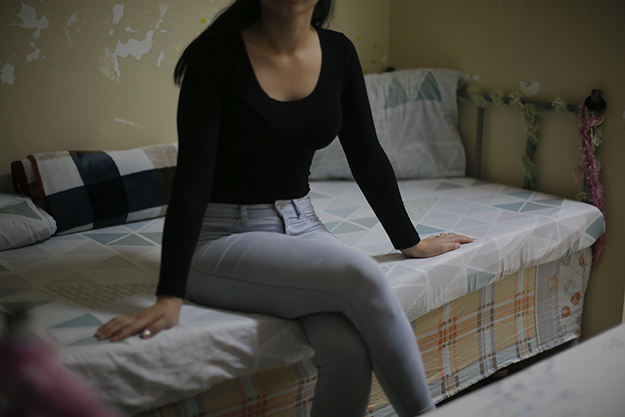
Arta was convicted for murder as a juvenile and has served half of her sentence. Photo: Gentis Zaskoku.
She does not want to talk about the crime because she says that it brings back the worst days of her life.
Arta takes care to keep her room clean, especially when she has “guests.” She says that ever since she heard that a journalist would come to interview her, she has kept the room clean and tidy. Her room is very different from others in the facility. She decorates it with colorful handmade objects to make her life in the facility more comfortable. The stuffed toys that her parents brought her are the only things that remind her of her life before she went to prison.
“I was more athletic. I really loved sports,” she says, staring at the wall as she speaks.
The center has sports facilities. She says she frequents them regularly. “It was my dream to continue playing sports. But now I’m thinking about pursuing a career in law.”
Arta finished technical high school while in prison. Now she is planning on pursuing studies at the Faculty of Law at AAB.
“Perhaps the injustices that I witness and experience every day have inspired me to study law,” she says.
She plans to begin her studies now that she has completed half of her sentence as, like other incarcerated juveniles, she gains the right to spend one weekend a month at home. The rest of her time will continue to be spent within the correctional facility.
According to the Juvenile Justice Code, all those convicted while juveniles must serve their sentences in a correctional facility for juveniles until the age of 23, and legally juveniles must be physically separated from adults in Kosovar correctional centers. But in practice this does not happen at LCC, which is the only correctional center in Kosovo for female convicts.
She only found out that her rights had been violated from other convicts, not from representatives of judicial institutions.
Arta, who turns 23 in February 2020, says she has spent her entire sentence in the same facility as the adult women.
Although this is not the only legal violation that incarcerated juveniles face, it is perhaps the most tangible. It is a reality that they face every moment of their lives behind bars.
Imprisoned among adult convicts
In November 2019, there were three juveniles at LCC: A convict, a detainee awaiting a court decision and a girl who was sentenced to educational rehabilitation; minors who commit crimes when they are under 16 have to serve educational sentences and cannot be sentenced to more than five years in prison.
Together with these juveniles, 42 adult women were serving sentences for various crimes in the same facility. According to LCC, they can accommodate up to 132 individuals, male and female.
Arta says that although she has been placed together with adult convicts while she should legally have still been treated as a juvenile, she only found out that her rights had been violated from other convicts, not from representatives of judicial institutions.
She says that there have been no incidents as a result of sharing her space with adult convicts. However, she believes that being exposed to them as a minor has not benefited her.
“We think differently from them,” she says. “There haven’t been any convicts who have spoken to me about how I should plan for my future or about the present, about my education and priorities.”
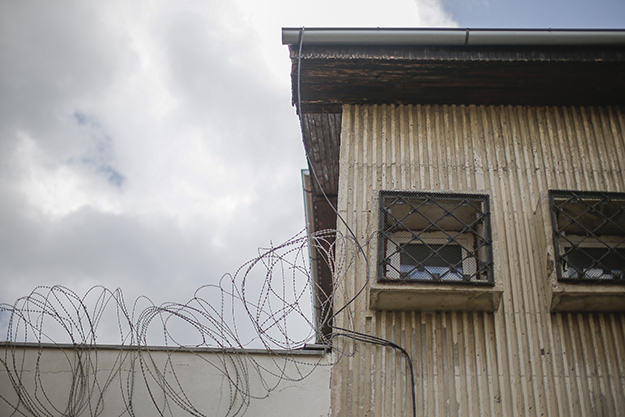
The Lipjan Correctional Center houses juvenile girls with adult women despite the law requiring them to be separated. Photo: Gentis Zaskoku.
Legal expert Kushtrim Palushi says that besides the clear illegality of placing minors and adults in the same facility, the correctional system has other deficiencies when it comes to implementing the law.
In addition to requiring detained minors to be separated from adults in accordance with age and gender, the Juvenile Justice Code states that they must also be provided with special social, educational, psychological, medical and physical aid. The same goes for minors who serve educational sentences; they must have a separate facility that has a day release option.
“Female minors should have a different routine and be treated differently from adults,” he says. “They should have more time outdoors and more social education programs.”

Arta takes pride in decorating her room. Photo: Gentis Zaskoku.
But the routine for both minors and adults is the same.
They wake up at 7 a.m. and eat breakfast at 8 a.m. Then, those who want to work can choose the laundry or kitchen. They get paid one euro per day.
Arta works in the laundry, where she works from 9 a.m. until lunchtime. After lunch, she can play sports for one hour. Then, those with a job can return to work until 4 p.m. After that, all convicts, with no exceptions, return to their wing.
The Juvenile Justice Code also says that a minor deprived of liberty must stay outside of their cell for at least three hours. But this does not happen in practice.
Klevis Vejsari from the Coalition of NGOs for Child Protection (KOMF) has monitored LCC and says that the placement of adults and minors in the same facility is detrimental to the objective of the correctional institution.
“Physical security has been prioritized so that there are no escape attempts,” Vejsari says. “But there are clear deficiencies in the work that is being done with these children.”
Juveniles are treated the same as adults.
The Council for the Defense of Human Rights and Freedoms (CDHRF) has prepared annual reports and notified the media about violations against juvenile girls who have been placed together with adult women at LCC.
Another violation against juvenile girls at the Lipjan Correctional Center is that all three categories — convicts, detainees and those sentenced to educational rehabilitation — are placed in the same facility.
Because there is no facility for juvenile girls, all three categories are accommodated in the same wing. Juveniles are treated the same as adults.
In her years at LCC, despite the severity of her crime, Arta has shared a room with girls who are serving educational sentences. “In my room, I had girls who were serving educational sentences and we were treated the same,” she says.
The Director of Prisons, Nehat Thaçi, says the low numbers of juvenile girl prisoners is why all females follow the same routines.
“We rarely have female minors as detainees. In order to apply these methods, we would have to have many more detainees or convicts,” he says.
This reasoning is also used to justify the lack of investment and resources given to the facility.

In the Lipjan Correctional Center, Arta did not know her rights were being violated. Photo: Gentis Zaskoku.
Isuf Ibërdemaj, the director of LCC since April 2019, agrees that different categories of convicts should not be accommodated in the same facility, as the law says. He says that in current circumstances it is impossible to implement all of these routines separately for each category but that he hopes that in the future they will have separate facilities for juvenile girls.
“As we currently stand with all female categories — namely convicted and detained adults, and minor convicts, detainees, as well as those serving educational sentences — it is absolutely impossible to implement all routines and rehabilitation programs in accordance with the Juvenile Justice Code,” Ibërdemaj says.
Social worker Tefik Halili, who has been working at LCC for the last 10 years, agrees that in the current circumstances, the placement of convicts of different categories in the same space is a necessity, although not ideal.
He explains that in the absence of dedicated spaces, the correctional center staff take ad hoc measures that are more or less limited to the accommodation of girls in specific cells.
“We try to classify them by their crimes,” Halili says. “For example, we try to accommodate girls that have committed crimes by accident or from negligence, or who have mitigating circumstances. They stay separately from those who have committed severe crimes such as murder, robbery or prostitution.”
According to Palushi, the responsibility falls on the Ministry of Justice, which proposes and makes laws.
“The Correctional Service functions within the Ministry of Justice and implements policies that are made by the Ministry,” he says. “The Correctional Service manages prisons and correctional centers.”
"Moreover, behavior models that are embraced by these minors could be positive in certain aspects. But there is the risk of emulating negative behavior.”
Natyra Agani, Psychotherapist and clinical psychologist.
In response to K2.0’s queries, the Ministry of Justice said that these questions should be addressed to the Kosovo Correctional Service.
What happens in mixed facilities
According to specialists, the effects of accommodating juvenile convicts in the same facility as adults can be multi-layered: There needs to be different treatment for both categories for their own security as well as mental health and reintegration processes.
However, when asked about the potential effects of this placement on minors, the mental health coordinator of Kosovo prisons, Granit Shatri, did not wish to comment. “I do not like to speak about the work that I do,” he said.
Other experts have highlighted the risks and consequences of accommodating juvenile convicts together with adults.
Natyra Agani, a psychotherapist and clinical psychologist as well as lecturer at the University of Prishtina (UP), believes it is inappropriate to accommodate minors together with adults because models of behavior could be emulated.
“They must be segregated based on age, gender and pathology of disorders,” Agani says. “The effects could be multi-dimensional but the most concerning are physical and emotional abuse. As well as different traumas. Moreover, behavior models that are embraced by these minors could be positive in certain aspects. But there is the risk of emulating negative behavior.”
LCC social worker Tefik Halili, who works for the welfare of minors together with the staff psychologist, says he has witnessed this effect in practice.
“We had one case where a minor was serving an educational sentence and was often influenced by certain women at the center,” Halili says. “They tried to achieve their goals through her. When they wanted to make noise, to destabilize the situation, they used her, the minor, as a tool. We — the professional staff — noticed that it was coming from the adults. They were inciting or motivating her to make trouble.”
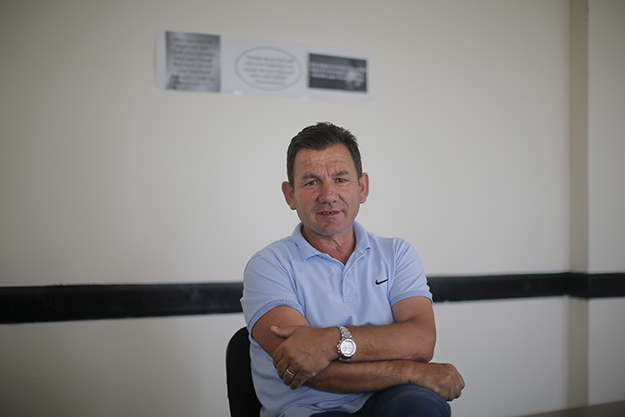
LCC social worker Tefik Halili has witnessed minors being manipulated by adults. Photo: Gentis Zaskoku.
Halili says that this happens due to the “impressionable character” and background of certain minors.
CDHRF official Valentina Demolli says it is unnatural to accommodate a minor in a cell together with adult women who have committed severe crimes or have long prison sentences. While monitoring LCC, she identified a case where there were heated discussions between adults and a minor.
“There was a case where a 16-year-old girl had problems with other women because she was a drug addict,” Demolli says. “As a result, she was harassed by the other women.”
Guards and wardens but no other professionals
The shortage of professional staff to work with minors also affects their access to the services they need.
In the Lipjan Correctional Center, there are 101 staff members in total, half in the men’s ward and the other half in the women’s ward, which includes supervisory and civil staff, as well as healthcare workers
“None of the staff are properly prepared to work with women, let alone with minors.”
Valentina Demolli, CDHRF
But among the medical staff there is only one psychologist for both male and female prisoners. Agani says it is impossible to give proper treatment with only one psychologist for about 100 convicts.
“Having a multidisciplinary staff that includes a psychiatrist, a social worker and a nurse would notably improve services for this target group,” Agani says. “Otherwise, the quality of services is questionable and obviously the professionals are not to blame for this.”
Arta says that in the last few years, she has visited the psychologist many times. This has helped her come to terms with her situation and also plan for the future.
She says that the staff treats her differently from other adult convicts because she is a juvenile.
“They go easier on me,” she says. “They do not see us [juveniles] as convicts. Rather they see us as their own children.”
Vejsari from KOMF says that the lack of suitable staff negatively influences the reintegration of convicts.
“There is a lack of educational staff who could work to rehabilitate minors, managing their behavior, because the objective is to prevent their re-victimization after being released,” he says. “We want to successfully reintegrate them in society.”
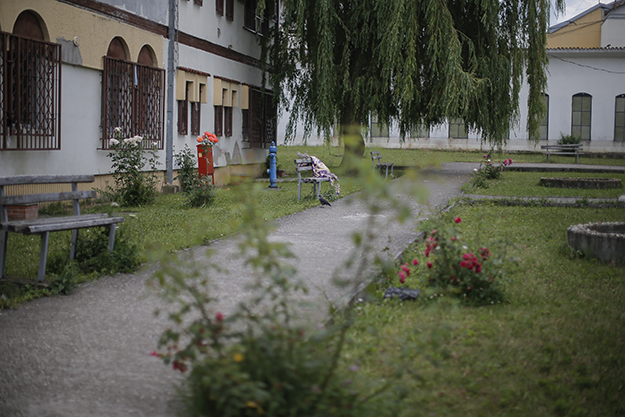
Organizations that monitor LCC say that the correctional center has a shortage of trained staff, but this is denied by the institution. Photo: Gentis Zaskoku.
Demolli meanwhile says that a lack of trained correctional staff who can work with delinquent minors is one of the main problems at LCC. CDHRF have reported this for years on end but nothing has been done to address these reports.
“None of the staff are properly prepared to work with women, let alone with minors,” she says. “They lack professional training and other related work that is necessary for working with [people in] these categories.”
However, Thaçi says that members of staff are regularly trained to work with minors. “Our staff are continuously trained through different internal and external projects,” he says.
Ibërdemaj agrees with his colleague Thaçi.
“The overwhelming majority of staff have 15 to 30 years of work experience,” Ibërdemaj says. “These staff worked before the war as well. Meaning that in addition to their experience, they have also taken part in local and international training on working with minors.”
His only concern is the old age of wardens and other staff at LCC. Ibërdemaj says this problem is notable not only at LCC but throughout correctional centers in Kosovo. He clarifies that they need to retire due to their age and certainly not due to a lack of professionalism.
Discrimination against juvenile girl convicts
At LCC, the men’s ward is situated next to the women’s ward. Male convicts are treated differently from female convicts. For male minors, at least some aspects of the law are implemented.
Juvenile convicts have separate facilities from adults. Over the past two years, those serving educational sentences have not shared facilities with convicts.
This favorable treatment for boys extends to other elements that are required by law.

Arta regularly uses LCC’s recreation yard for sport. Photo: Gentis Zaskoku.
Male minors can benefit from having their prison sentences changed to educational measures for good behavior. This is determined by a panel within the Correctional Center that assesses the behavior of minors.
But while the panel is tasked with assessing both sexes, boys are the only ones who have benefited from more privileges as a result of good behavior by being placed in the educational correctional center.
“Females do not have this opportunity,” Ibërdemaj says. “At the moment we are unable to do this, because the facility does not enable this kind of physical segregation.”
According to the director, the center is well-equipped, has recreation halls, reading halls and a library as well as a workshop for training.
Demolli from CDHRF says that the center is also designated for girls serving educational sentences. But due to their low numbers and the staff shortage, only boys have been allowed in the center.
Vejsari from KOMF points out that the Juvenile Justice Code requires the accommodation of juvenile convicts in an educational correctional center.
However, discriminatory practices extend further than physical opportunities in these facilities and environments.
Both sexes are treated differently in the vocational training programs for reintegration as well. Women are provided with courses “for women,” and men have courses “for men.”
Along with some adult convicts, Arta has participated in a hairdressing course. The only other option available was a tailoring course.
“I chose hairdressing because I like it. We went to class three times a week, for six months,” she says. “If I’m not mistaken, boys are also offered IT courses, which I would love to participate in.”
Arta has not been told that she can participate in other courses. She hasn’t requested to participate in the IT course yet.
Demolli from CDHRF says that at LCC there is more or less a gender-based designation for these courses; until now the only courses that girls and women have participated in are the hairdressing and tailoring courses.
Unlike male minors, girls rarely re-offend after being released.
Director Ibërdemaj says that he does not know how this functioned before he took over this position last April. He added that under his mandate girls will be able to participate in IT courses as well.
“I encourage women to participate in courses for IT, electronics and other training, not just courses for hairdressing and tailoring,” he says. “But those are the courses that are usually attended by men.”
Although the new director of LCC says that he aims to change this distinction between the treatment of men and women, other initiatives for equal treatment go beyond his competencies.
For example, all inmates can write to the president of Kosovo to request amnesty. The president has the right to grant amnesty in accordance with Article 84 of the Constitution. In late 2018, Arta wrote to the president seeking amnesty but she never received a response.
Demolli from the CDHRF says that female convicts have not been granted amnesty in recent years despite their excellent behavior. He says this is another form of discrimination against women serving sentences.
The annual monitoring from CDHRF found that unlike male minors, girls rarely reoffend after being released.
According to Demolli, in recent years there have only been two or three cases where juvenile girls have reoffended.
With regard to recidivism, developmental psychologist Agani believes that programs for at-risk juveniles — that are just about nonexistent in Kosovo — must be designed and implemented.
“Empirical evidence has shown that reintegration must be prioritized, to prevent recidivism,” Agani says.
A new facility
The men’s adult Detention Center in Lipjan will be closing later this year and will reopen as a facility for female convicts, at least temporarily.
“The center will be redesigned for female convicts and detainees, and for female juvenile convicts, detainees and those serving educational sentences,” Ibërdemaj says.
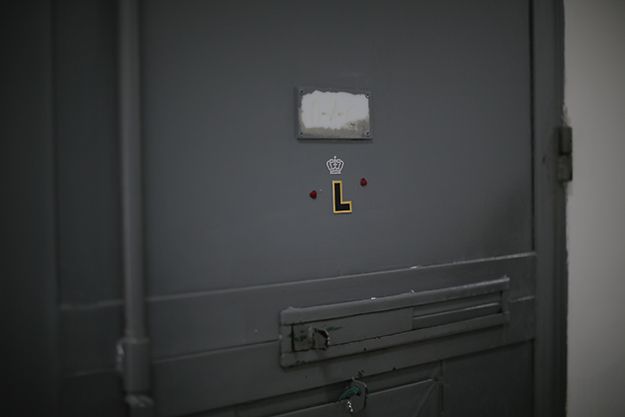
Starting from later this year, the LCC will house only juvenile boys as women of all ages will be housed in another facility. Photo: Gentis Zaskoku.
Where they are currently accommodated, minor girls and boys share the same recreational court. This has been reported by CDHRF yearly.
Despite sharing the recreational court, Arta says that they are not harassed by male minors.
“We do not have contact with them but we might see them on our way to work, to the hospital or elsewhere,” she says. “So we only see them as we move around the facility.”
The Director of Prisons, Nehat Thaçi, says that the new facility will enable the segregation of minors and adults.
“Minors will be separated from adults,” he says. “The facility will be the same but the two categories will be segregated. Conditions will be of the highest standard.”
The director does not provide details on how they will implement the segregation of the two categories and how this will influence the treatment.
The low level of delinquency among juvenile girls is also penalizing them. According to the justifications of representatives of the correctional system, the low number of convicts does not justify the necessary investment and resources for treating them fairly based on conditions as required by law.
Legal expert Palushi says that all girls who have served their sentences at LCC have had their rights violated and that they can take legal action for damages because of this.
“Female minors who have been imprisoned or detained together with adults can sue the state for the emotional damage that they might have suffered,” Palushi says. “This can influence their lives.”
He adds that the state cannot use the justification that due to the low number of juvenile girl convicts, they must serve their sentences together with adults. According to him, this justification does not stand.
“Under no circumstances can a female minor spend time with a woman who is serving a sentence for a violent crime, for narcotics related crime, etc.,” Palushi says. “Moreover, the state should provide opportunities for education, vocational training programs, basically services that are provided in youth centers.”
In the meantime, girls like Arta become women who come out of the correctional system with little support or guidance.K
* This name has been changed to protect the individual’s identity in order not to affect her reintegration into society at the end of her sentence.
Feature Image: Gentis Zaskoku.
This article has been written as part of the second cycle of the Human Rights Journalism Fellowship Program supported by the European Union Office in Kosovo, co-financed by the project ‘Luxembourg support to civil society in Kosovo,’ financed by the Government of the Grand Duchy of Luxembourg and managed by Kosovar Civil Society Foundation (KCSF), as well as from the National Endowment for Democracy (NED). This program is being implemented by Kosovo 2.0, in partnership with Kosovar Center for Gender Studies (KCGS), and Center for Equality and Liberty (CEL).
Its contents are the sole responsibility of Kosovo 2.0, KCGS, and CEL and do not necessarily reflect the views of the donors.














